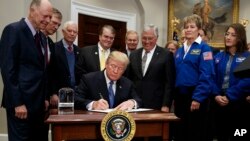Pledging that "America will once again reach for the moon," President Donald Trump Monday ordered the National Air and Space Administration to revive the manned space exploration program that was suspended in 2011.
"[This] marks an important step in returning American astronauts to the moon for the first time since 1972 for long-term exploration and use," Trump said. "This time, we will not only plant our flag and leave our footprint, we will establish a foundation for an eventual mission to Mars. And perhaps, someday, to many worlds beyond."
Surrounded by several astronauts and former astronauts in a White House ceremony, Trump paraphrased Neil Armstrong, who famously said "That’s one small step for man, one giant leap for mankind," when he first set foot on the lunar surface in 1969.
"This is a giant step toward that inspiring future and reclaiming America’s proud destiny in space," Trump proclaimed.
Among those attending the event were two of the 12 humans ever to have walked on the moon, Edwin "Buzz" Aldrin, who touched the surface shortly after Armstrong’s historic step, and Harrison "Jack" Schmitt, who did it as a crewmember of Apollo 17, the last manned mission to the moon in 1972.
Trump noted that the signing ceremony came exactly 45 years to the day after Schmitt’s moonwalk with Apollo 17 commander Eugene Cernan.
David Kring, head of the Lunar and Planetary Institute at the Universities Space Research Association, says the first unmanned launch in the program to get back to the moon could come in a little more than a year.
"2019 is Exploration Mission One. That will launch the Orion crew vehicle and will orbit the moon without astronauts," Kring told VOA. "Then in 2023 the vehicle launches again, this time with astronauts who will orbit the moon and return. After that is successful, we can actually deploy the astronauts in space (in between the earth and the moon)," he said.
Kring, who led a joint academic-industry-NASA design team to develop a robotic lunar lander and rover system that can be deployed anywhere on the lunar surface, said he expects the first manned mission to the lunar surface probably will take place about 2030.
"The current schedule within my own group includes a human-assisted lunar sample return mission about 2025 or 2026. This would be a robotic mission on the surface that would collect samples and then launch them into orbit where the astronauts would collect them and return them to earth," Kring explained. "We’ve also designed a series of five landing sites for human astronauts, NASA astronauts from 2030 to 2035."
Trump has long said he wants the United States to return to space exploration in a big way. Last March he signed the first NASA funding authorization in more than six years, endorsing a "stepping stone approach to exploration" with "missions to intermediate destinations in sustainable steps" while maintaining a long-term goal of human missions to Mars.
The $19.5 billion bill ordered NASA to come up with an "initial exploration roadmap" that is due this month.
In June he signed an executive order re-establishing the National Space Council and naming Vice President Mike Pence as its head.
In Monday’s White House signing ceremony, Trump recalled the great accomplishments of the nation’s immigrants who came to the country with a pioneering spirit "that few dared to dream."
"Today the same spirit beckons us to begin new journeys of exploration and discovery. To lift our eyes all the way up to the heavens and once again imagine the possibilities waiting in those big beautiful stars if we dare to dream big," Trump said.
The USRA’s David Kring said all the data and much of the hardware needed to put astronauts back on the moon has already been developed.
"We actually made tremendous progress in the Constellation program of the early 2000s before it was cancelled," Kring said.
"We have a prototype design for a rover that can carry astronauts long distances over the lunar surface. We’ve done mission simulations for up to 28 days on the lunar service. We have an Orion crew vehicle that has already had one test flight. We have a large rocket under construction. What we’re still missing is the lunar lander that would carry crew to the lunar surface."
Kring told VOA that in his long career, some of the wisest words about proceeding in space exploration had come from astronaut Schmitt.
"He told me that the fastest way to Mars is through the moon," Kring said. He’s absolutely right. We have to develop the capability and the work force to put humans back on the lunar surface, and once we have learned how to do that we’ll be in a better position to carry our astronauts to Mars."
Trump Orders Revival of US Manned Space Exploration Program
update

WHITE HOUSE —







